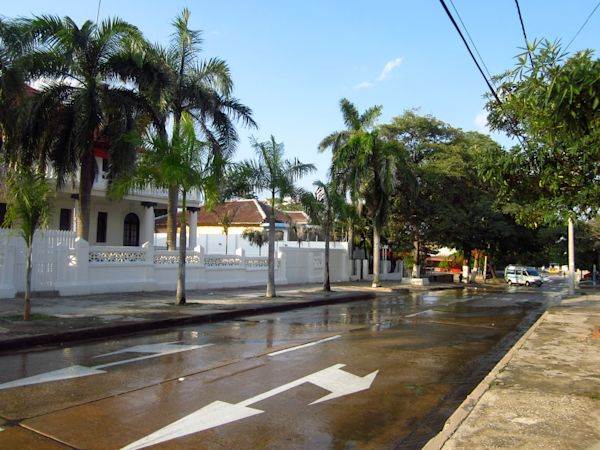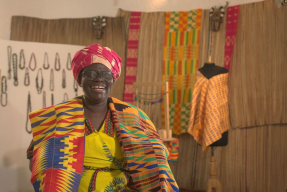
Rose Larsen | KF19 | Colombia
My first glimpse of Barranquilla, Colombia was of wide avenues lined with tropical trees bearing unfamiliar fruits; a busy, congested city sprouted up in a tropical coastal jungle. Having lived my entire life in the cool, foggy embrace of San Francisco, my first few weeks in Barranquilla have involved quite a bit of adapting.
Since most people’s picture of Colombia seems to involve guerillas, kidnappings and cocaine, I thought I’d share what life is REALLY like, here on the Caribbean coast of Colombia.
It’s Too Darn Hot!
The most striking difference between Barranquilla and anywhere else I’ve ever lived is the humid, oppressive heat. At night, it is a cool 80 degrees; during the day it gets up in the 90s and I come home each day sticky and exhausted. Because of this, no one walks anywhere, taking taxis or buses even short distances – a fun day out for the family might be a stroll through the local mall, just because it’s air conditioned!
The heat is often supplemented by sudden heavy rains which dump down on the city for between 20 minutes and an hour, leaving the streets flooded with “arroyos,” rivers of rainwater and trash that flow rapidly and dangerously down the streets into the river. (See a previous Kiva fellow’s blog about arroyos for some terrifying videos).
¿Qué significa sancocho, sipote y guayabo?
Another challenge for me has been adjusting to the local dialect. Colombian Spanish varies wildly by region, with at least 10 different dialects spoken, varying in both accent and vocabulary. Costeño Spanish, that spoken by people from Barranquilla and the nearby Cartagena and Santa Marta, is notoriously fast and slurred. When two Costeños speak to each other, I catch about 30% of the conversation, if I’m lucky. A combination of the speed and the strange slang made up of indigenous Caribbean words can leave me feeling lost in many conversations. Luckily, Costeños are very accommodating people and make an effort to slow down for me.
Their Hips Don’t Lie
Given that Barranquilla’s most famous progeny is Shakira, is that what most Barranquilleros listen and dance to? If my one night out in a swanky Barranquilla night club (located inside a mall!) is any indication, no. The popular music around here is Vallenato, the raucous crossbreed of cumbia and indigenous Caribbean Colombian rhythms featuring an abundance of accordian:
'Even though Vallenato is Colombia’s equivalent of country music (no offense, country music fans!), that doesn’t stop girls from dressing to the nines when getting ready to go out: fancy dresses, five inch heels, and heavy make-up. Then they dance for hours to a mixture of vallenato, reggaeton and salsa, with a few Rihanna songs thrown in. And so far, the stereotypes seem to be true: Colombians are incredible dancers.
Guayava, Nispero and Lulo, oh my!
Adapting to the food in Barranquilla has been an exciting adventure. The basic meal includes beans, coconut rice, salad, cooked plantains, and some kind of meat, along with a soup.
But the really exciting part is the huge variety of fruit available here! Vendors like Kiva borrower Luis Enrique sell whole fruits, slices of watermelon or orange juice by the side of the road, and shops called “Fruteras” offer an amazing array of choices, from the familiar bananas, oranges and apples to the more exotic mangos, passion fruits and guavas, to the completely unknown níspero, zapote, and lulo!
On one of my first days, I headed to the supermarket and bought one of every new fruit I could find. Now, I try to stop by a fruit stand a few times a week for some níspero juice or a zapote smoothie.
~~~
Some of these changes are exciting, some are hard, and some are painful (okay, mostly the heat). But what makes it all worthwhile being here?
The warm, welcoming people of the Colombian coast, whose friendliness is unrivaled.
Last week I had my first chance to see what Kiva borrowers are like here in Barranquilla. I headed to a vibrant, colorful neighborhood called Ciudadela 20 de Julio with José, a loan officer for Fundación Mario Santo Domingo, the Kiva partner I will be working with for the next four months. We wandered around a group of stands in a plaza near the soccer stadium called Metroplaza, and it seemed that every other business had taken out a Kiva loan.
First we chatted with a man selling bracelets, temporary tattoos and handicrafts, then met a friendly older couple selling jerseys for “the best team in the world,” Barranquilla’s Juniors (I suspect there might be a slight bias there).
My favorite stop was at a fast food restaurant. Yudanis and Adrian told me that they had taken out about 5 loans from Kiva, using them to buy kitchen appliances, including their oven featured in this photo roasting some chickens. They moved to this spot recently and have seen an increase in sales from soccer fans and workers in the area having lunch.
As I walked away, Yudanis came running after me, handing me this keychain to remember her by.
Yes, it’s definitely all worth it.
~~~
Rose Larsen is a member of the 19th class of Kiva Fellows, serving in Barranquilla, Colombia with Fundación Mario Santo Domingo. Become a member of FMSD’s lending team, lend to one of their borrowers today, or apply to be a Fellow!
PREVIOUS ARTICLE
Happy Birthday Kiva! Celebrate Kiva's 7th Birthday in your own city! →NEXT ARTICLE
New Field Partner: Novica connects lenders with artisans around the world →




















